
|
|
SUBSIM: The Web's #1 resource for all submarine & naval simulations since 1997
 |
SUBSIM: The Web's #1 resource for all submarine & naval simulations since 1997 |
 10-22-08, 04:04 PM
10-22-08, 04:04 PM
|
#46 | |||
|
Ocean Warrior
 Join Date: Jan 2008
Posts: 2,909
Downloads: 77
Uploads: 11
|
Quote:
Quote:
Quote:
I didn't forget to use the TDC... It's also not a case of not bothering with the TDC. If I could use the TDC to find an accurate firing bearing for a zero gyro angle in a simple way, without having to re-enter information, then I would use it. My aim is only to get a firing bearing for a zero gyro angle shot so that range is not important. I also wanted to get an exact 45 degree torpedo track angle. If you can show me a way to get that from the TDC, I'd probably use it. It's only a couple of lines, it's not like you have to complete a 3d sketch of the ship you are shooting at. Yes, you can get an innacurate solution whose innacurasy doesn't matter because you are shooting from 800 yards, but if you are shooting from 800 yards, you might as well just shoot with a lead angle of speed + 3 degrees with zero gyro angles.
__________________
-------------------------------- This space left intentionally blank. |
|||

|

|
 10-22-08, 04:52 PM
10-22-08, 04:52 PM
|
#47 | |
|
Admiral
 Join Date: Aug 2007
Location: Suomi, sauna, puukko, perkele
Posts: 2,346
Downloads: 39
Uploads: 0
|
Quote:
I have one huge problem with the 45-degree attack: In SH4 ships usually turn towards the torpedoes when they see them. In a 45-degree zero-gyro angle attack the torpedo track angle is already 45-degrees, and when the ship turns into the torpedo the the angle is even less resulting in plenty of duds. You can counter this to some extent by using fast speed in the torpedoes, but you all know how reliable the early war ones are with that setting... |
|

|

|
 10-22-08, 05:04 PM
10-22-08, 05:04 PM
|
#48 |
|
Commodore
 Join Date: Jul 2002
Posts: 608
Downloads: 25
Uploads: 1
|
Or, after setting the target's AOB (45 degrees left/right +/- lead), go to the attack map and take a look at the torpedo track line (green). If your sub is already oriented like you've planned (for a 45 degree attack), the green line will tell you if you're set up for a zero-degree shot.
If not, eyeball the change, adjust your AOB and crosshairs accordingly, and send a new bearing to the TDC. Otherwise, leave your crosshairs where they are and shoot as the "juicy parts" of your target sail into your crosshairs. Edit: One way to make manual range changes to the TDC (based on a thread I can't find anymore). 1.5 \Data\Menu\cfg\Dials.cfg: made changes so that manual input on the range meter could be increased to max range. [Dial58] Enabled: “RelativeDrag=Yes” to steady the index marker (to keep from “chasing the dial.”) [Dial59] Enabled: “Cmd=Set_tgt_sel_value;” Enabled: “CmdOnDrag=Yes” Enabled: “RelativeDrag=Yes” to keep wheel from spinning when attempting to dial a range. Last edited by Munchausen; 10-22-08 at 05:20 PM. |

|

|
 10-22-08, 05:43 PM
10-22-08, 05:43 PM
|
#49 | |
|
Ocean Warrior
 Join Date: Jan 2008
Posts: 2,909
Downloads: 77
Uploads: 11
|
Quote:
Some people are more visual in their problem solving and may find drawing a solution much more intuitive than someone who is more word orientated. I think for people that want to get into manual targetting, but are a bit worried about the TDC, the simpler the better. This is after all, who this method is for. It works not only for 45 degree attacks, but for 90 degree attacks, 60 degree attacks, even attacks from behind and will give the right solution every time, so people may well see their hit rates increasing with these zero gyro angle shots. The simpler the better if you ask me. Unless that simplicity gives you wrong solutions of course  . .
__________________
-------------------------------- This space left intentionally blank. |
|

|

|
 10-22-08, 07:27 PM
10-22-08, 07:27 PM
|
#50 |
|
Admiral
 Join Date: Aug 2007
Location: Suomi, sauna, puukko, perkele
Posts: 2,346
Downloads: 39
Uploads: 0
|
I figured by your posts you'd know a thing or two about TDC
I forgot to add to that explanation that it doesn't give a gyro angle of exactly zero degrees without trial and error, but close. Your precision won't suffer becuase the TDC is still used to calculate the new gyro angle. I tried the drawing method and it is definitely faster and more precise if you want the gyro angle to be exactly zero degrees. Imho still the best way of them all, even though it has nothing to do with this thread, is using the PK  By the time the target gets into a firing position you'll have verified the solution so many times there should be little error left. Firing spreads is easy without having to keep the scope up for aiming, and you can also maneuver the boat around and fire at any time without having to recalculate anything. Gyro angle and torpedo track angle will also be constantly available and useable in deciding the best moment to fire. By the time the target gets into a firing position you'll have verified the solution so many times there should be little error left. Firing spreads is easy without having to keep the scope up for aiming, and you can also maneuver the boat around and fire at any time without having to recalculate anything. Gyro angle and torpedo track angle will also be constantly available and useable in deciding the best moment to fire.
|

|

|
 10-22-08, 07:29 PM
10-22-08, 07:29 PM
|
#51 |
|
Navy Seal
 |
The vector analysis, even if it were completely useless is an indispensable tool because it teaches you why the attack works. It gives you confidence in your method. Confident people make fewer mistakes because they remember the steps and their purpose while they go through the procedure. It helps to be able to visualize what is really going on.
Fortunately vector analysis is also so useful that you could do the whole attack if the TDC were thrown overboard. Overboard, if you haven't guessed, would be a nice place for the TDC in Nisgeis' sub. He has a unique and very productive outlook on how to shoot a torpedo. He has no need but idle curiosity to know anything about the TDC. @Fincuan, the problem with the PK is that it needs a range. Our attack methods work so well at extreme ranges simply because range cancels out of the equation and becomes irrelevant as long as the torpedo can run long enough to get there. We, for the most part, are unwilling to cheat by manually inputting a range to the TDC based on a visual sighting to match the pip on the nav map. I personally have no problem at all doing precisely that with radar. A future iteration of the John P Cromwell technique will use the PK to do a divergent spread: stern, MOT, bow. This should result in near simultaneous strikes at all three points. If the target does the predictable during clear weather and turns into the attack, he will merely be struck by two instead of three. A longitudinal spread, with torpedoes advancing in a single column is relatively easy to avoid. A divergent spread is not! This spread, by the way, was advocated by Nisgeis in one of our earliest talks for formulating this technique. Anyone who wants to try this out in the safety of the balmy waters off the coast of California near Catalina Island with nobody around but your target tanker, here you go. Just unzip it into your Wolves of the Pacific\data\single missions directory.
__________________
Sub Skipper's Bag of Tricks, Slightly Subnuclear Mk 14 & Cutie, Slightly Subnuclear Deck Gun, EZPlot 2.0, TMOPlot, TMOKeys, SH4CMS Last edited by Rockin Robbins; 10-22-08 at 07:53 PM. |

|

|
 10-22-08, 08:26 PM
10-22-08, 08:26 PM
|
#52 | |
|
Commodore
 Join Date: Jul 2002
Posts: 608
Downloads: 25
Uploads: 1
|
Quote:
|
|

|

|
 10-22-08, 09:10 PM
10-22-08, 09:10 PM
|
#53 |
|
Ace of the Deep
 Join Date: Jun 2005
Location: Palm Beach, Florida
Posts: 1,243
Downloads: 53
Uploads: 8
|
Sorry... I cut the 70° in half to 35° I guess I should've cut the 20° in half too.
(and I'm just gonna claim stupidity for saying 35.5° is half of 70°) Assuming you're on a 45° track to the target TC and you just set AoB as 35° you should be able to get a +-5° solution (close enough to zero) at the 10° bearing. You would set the target speed for whatever the target speed is and let the TDC calc the +-5 track. Just leave distance at ohhh... 1000-1500 or so and you should be fine. When I suggested a 20° approximation for the 90° approach angle I was assuming you were going to use your TDC to get an exact track solution (but close enough to zero gyro) to hit anything inside of 2000 yds (maybe further). I haven't tested it, but I would think that a +-5 gyro angle wouldn't introduce enough error to miss inside of 2000yds. It's only the little bit of torpedo advance that skews the solution with regard to distance, and I doubt a few degrees is gonna matter too much if I just set a 1500yd distance and forget about it. So you're on a 45° track and target is moving at 12kts. Try setting aiming wire at 10° and AoB 35°, speed 12 and MARK (hit input button). That should give a solution close to zero gyro. Now fire as points of interest pass the wire on the 10° mark. I was just looking for ways to simplify the TDC data entry and allow the TDC to solve for the angle... similar to Fast-90. Notice the only variable above is speed, I don't need to keep a lookup table of degrees for zero gyro shots. But it's up to you all if you want to do the math, if you like super precision and hitting targets at 8000 yards that's fine too.  10 and 35 seem to work OK for a 46kt torpedo... and what's the other torp speed? ...probably close enough for other speeds too. Last edited by XLjedi; 10-22-08 at 09:23 PM. |

|

|
 10-22-08, 09:38 PM
10-22-08, 09:38 PM
|
#54 |
|
XO
 Join Date: Jan 2002
Posts: 409
Downloads: 28
Uploads: 0
|
Back in the days of Sub Battle Simulator, I used a manual plot and the following forumula for a firing solution: Range to track, at point of torpedo hit, divided by torpedo speed, equals torpedo run time to target. Run time to target X Target speed = distance travelled by target during torp run. plot the distance travelled by target back along its track from the point of impact and when the target gets to that spot you fire the torpedo It really doesnt matter what the aob is . It seems like this Cromwell method is based on the same idea. Based on my experience with Sub Battle Simulator (we're talking hundreds of hours) , I know it is a good method.My question is, what is the importance of the 45 AOB? I really dont think it makes any difference, except that the smaller the angle the smaller the profile of the target at the point of impact. The video and written instructions are great, good job! Joe S
|

|

|
 10-23-08, 01:53 AM
10-23-08, 01:53 AM
|
#55 | ||
|
Commodore
 Join Date: Jul 2002
Posts: 608
Downloads: 25
Uploads: 1
|
Quote:
1. Took two fixes of the target, three minutes apart. 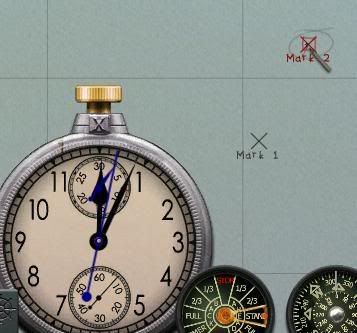 2. Drew a line through both fixes and extended it past my sub's present position.  3. Determined the target's speed ... about 12 knots. 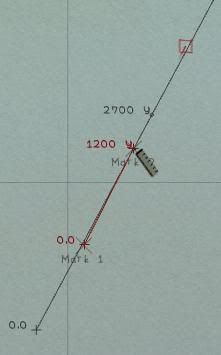 4. After making a random turn (nothing specific ... just somewhere between 45 and 90 degrees) toward the target's track, checked my heading on the compass ... which happened to be about 273 degrees. 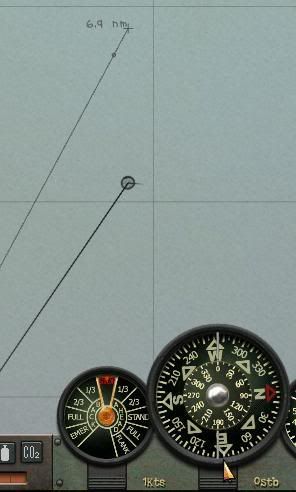 5. Plotted my heading (273) on the navigation map. 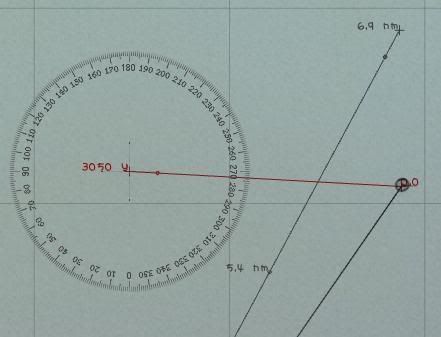 6. Overlaid a "hypothetical" triangular solution where:
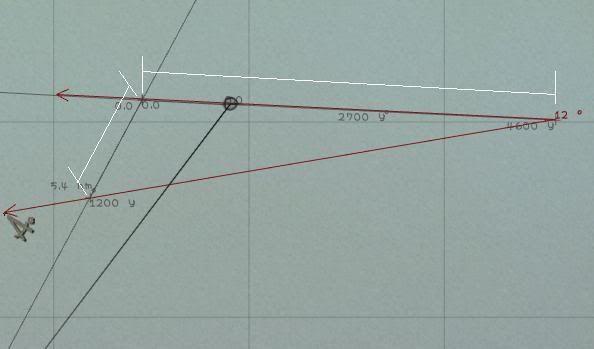 Note: The two "heading" sides are marked off with white goalposts and the angle opposite the target's heading is in red. The 12-degree (lead) angle will work for the (shorter) real distance between target track and sub's position because the ratio between the hypothetical triangle and the actual triangle is the same. 7. Transposed the lead angle (12 degrees) to sub's present position. (This step isn't necessary ... it just makes it easier to judge how close the target is to the firing point.) Note the ratio between the two triangles. 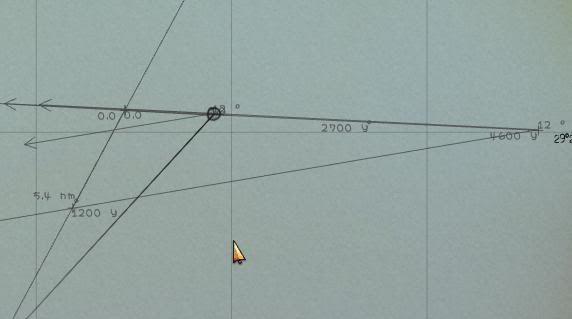 8. Identified the target.  9. Set the torps: high speed, contact/influence, 17 feet (and then opened tubes 1, 2, 3 and 5). 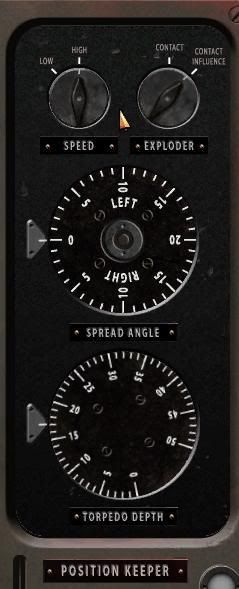 10. Checked the attack map to make sure gyro angle was set to zero. 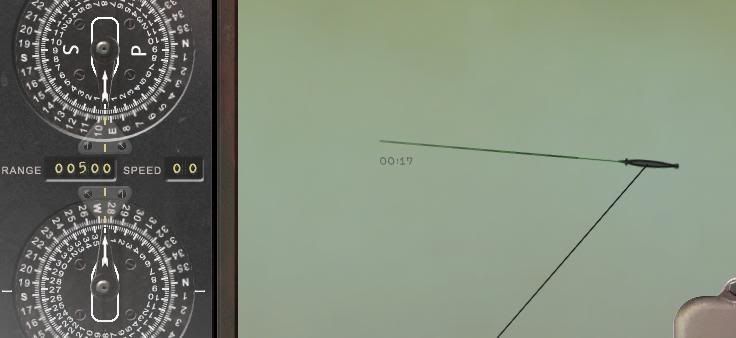 11. Turned periscope 12 degrees left (to 348 relative) and fired as the "juicy parts" of the target sailed past the crosshairs. 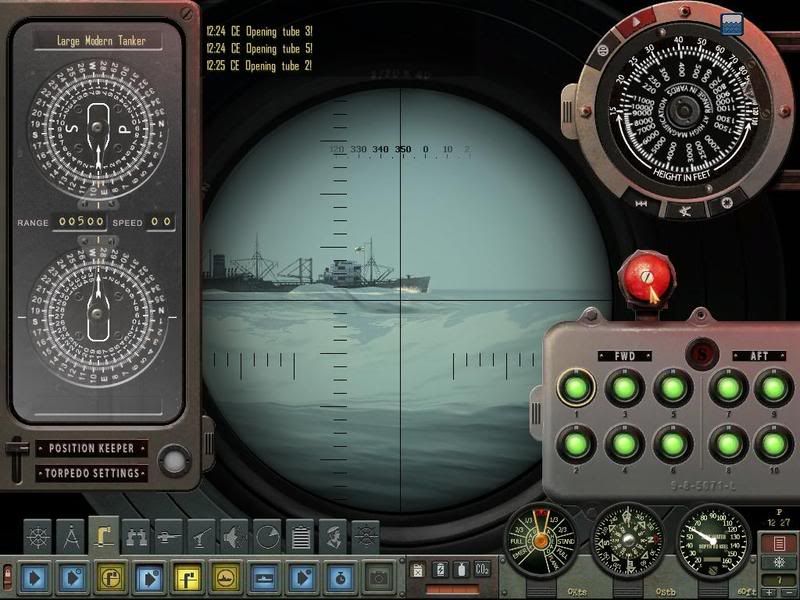 12. Hit ... slightly after of aim point. The last three torps hit just about on target. None missed. 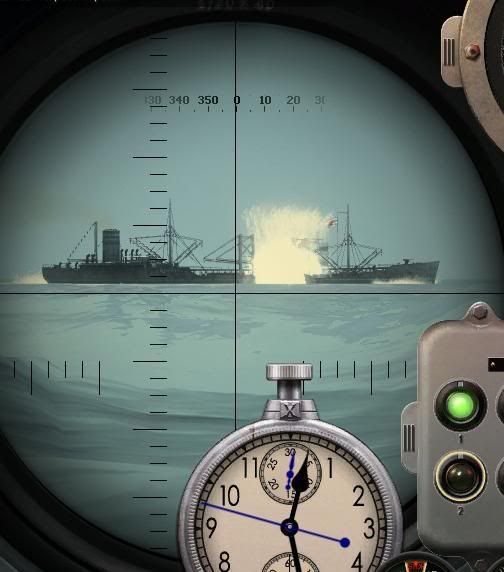 So, was that bass-ackwards or what? |
||

|

|
 10-23-08, 05:41 AM
10-23-08, 05:41 AM
|
#56 |
|
Navy Seal
 |
Bass-ackwards??????? You're dead on! And that makes vector analysis worth knowing. I just started some research. It's really weird news. It really doesn't matter except for curiosity. I'll start another thread for that one.
Suffice it to say that you better be taking zero gyro shots at extreme range or putting a high number in the range for the TDC when you shoot. But it gets worse....
__________________
Sub Skipper's Bag of Tricks, Slightly Subnuclear Mk 14 & Cutie, Slightly Subnuclear Deck Gun, EZPlot 2.0, TMOPlot, TMOKeys, SH4CMS |

|

|
 10-23-08, 09:01 AM
10-23-08, 09:01 AM
|
#57 | |
|
Ocean Warrior
 Join Date: Jan 2008
Posts: 2,909
Downloads: 77
Uploads: 11
|
Quote:
__________________
-------------------------------- This space left intentionally blank. |
|

|

|
 10-23-08, 09:05 AM
10-23-08, 09:05 AM
|
#58 | |
|
Ocean Warrior
 Join Date: Jan 2008
Posts: 2,909
Downloads: 77
Uploads: 11
|
Quote:
__________________
-------------------------------- This space left intentionally blank. |
|

|

|
 10-23-08, 09:28 AM
10-23-08, 09:28 AM
|
#59 | |
|
Ocean Warrior
 Join Date: Jan 2008
Posts: 2,909
Downloads: 77
Uploads: 11
|
Quote:
If you reversed time back to one hour before the crash, assuming they both travelled at a constant speed on the same course, they would both arrive in one hour's time at the crash. At any given point in time, Car A would be at a bearing of 296.5 from car B and car B would be at a bearing of 26.5. Running time forwards, as they get closer to the crash point, the bearings remain the same, but the range reduces. This is know as a contant bearing, reducing range situation and is a definite sign you will collide. The above is for a crossroads at 90 degrees, but it doesn't matter what angle the cars are approaching each other from. If you know they will collide, you can work out where they will be before the crash. Even if they were approaching each other head on, the same would be true. Though the bearings would be 0 for each car. If you take any collision problem, where you know the angle at which two objects will collide, and you know the speeds, then you can work out where they were before the crash. Then you can also work out where one object should be in order to collide with another. If you are in car B and you want to deliberately crash into Car A, and you know that car A is travelling at 30 MPH at a course 90 degrees to you, then you can work out that if you want to hit him travelling at 60 MPH, you would hit car A, if you were approaching the crossroads and Car A was at a bearing of 26.5 degrees. If he was at 10 degreesm he'd pass ahead of you and if he was at 40 degrees, you'd pass in front of him. It all relies on knowing the angle of intersection and the speeds to work out what point you need to start off to ensure a hit.
__________________
-------------------------------- This space left intentionally blank. |
|

|

|
 10-23-08, 09:54 AM
10-23-08, 09:54 AM
|
#60 | ||
|
Ocean Warrior
 Join Date: Jan 2008
Posts: 2,909
Downloads: 77
Uploads: 11
|
Quote:
Quote:
The Dick O'Kane method works for close in targets, but has certain things removed from the target problem that become apparent when shooting at longer ranges. The first is that you need to put a range into the TDC and for most bearings, this means a small gyro angle. A large gyro angle, as we know needs very precise range data to score a hit and setting a solution for 1,500 yards for a target 4,500 yards away will mean a significant range error. The gyro angle is further exagertaed, as the reach on a mk. 14 is 200 or so yards, so for a target 1,500 yards away, the gyro angle is calculated for a run of 1,300 yards. This increases the gyro angle and increases the error set for the gyro angle. For such range errors, even a small gyro angle will result in a miss at longer ranges. The second problem the static PK has is the AoB of the target and rnage aren't adjusted, as you close on the target's track, the AoB will also change and that not being updated adds a small error into the gyro angle already calculated. This effect is reduced if coming on for a slow creeping submerged attack, but is noticable with a high speed surface attack. Errors are introduced here into the firing soilution you have. The target's own movement is also taken into account when closing on a track. These errors sometimes cancel each other out and sometimes they compound each other.
__________________
-------------------------------- This space left intentionally blank. |
||

|

|
 |
|
|
